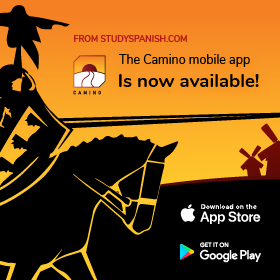Cultural Notes
-
Topics
- A Jungle Hike Through Shuar Country
- Asturias, the Natural Paradise of Spain
- Camels in South America (new)
- Caño Negro Wildlife Refuge
- Canopy Walking
- Celestún
- Cervantes
- El Chimborazo
- Christmas Eve and Christmas Day
- Christmas Time
- Climbing Cotopaxi
- Courtyards of Latin America
- Covadonga, un Santuario Histórico
- Crucifix Art in Latin America
- Cuzco
- Eating Street Food In Mexico
- Ecolodge Pioneers in Chiapas, Mexico
- El Greco
- The Sack Man
- La Sidra de Manzana; Deliciosa Tradición
- Floating Islands of Uros (ADVANCED LEVEL)
- Friends of Teacapán
- Las tortugas de caparazón gigante
- Guanajuato
- Guelaguetza
- Huichol Yarn Paintings
- Las cataratas de Iguazú
- Kings Day
- La Alhambra de Granada (ADVANCED LEVEL)
- La Tovara
- Laguna Quilotoa
- The Houses of the Indianos
- Lima
- Machu Picchu
- Madrid
- Mangroves of Pacific Mexico
- Mazatlan Aquarium
- Meet Minnie
- Mexican Cemetery Walk
- Monarch Butterfly Sanctuary Michoacán Mexico
- Morning in Teacapán
- El perro de monte
- Nopal
- Old Year
- Paella
- Papallacta Hot Springs
- La Piñata
- Quetzaltenango
- Ride the Bus in Mexico
- Running with the Tarahumara
- Salvador Dalí
- San Blas
- Sculptures In Leather
- Spanish Culture
- Spray Paint Art
- Las tiendas
- Studying Spanish in Latin America
- El tango
- Techos de México
- Teitos of Somiedo - Asturias
- Termites
- El Álamo
- Andean Condor (new)
- The Animal Carvings of Oaxaca - alebrijes
- The Bakeries of Mexico
- The Black Pottery of San Bartolo Coyotepec
- The Bronze Sculptures of Alejandro Colunga
- Cabrales Cheese Festival (new)
- The Cardón Cactus
- The Cenotes Of Yucatan
- Los conquistadores
- The Copper Work Of Santa Clara del Cobre
- The Island of Janitzio
- The Meat Markets of Mexico
- La Noche de San Juan
- The Night of the Radishes
- The Paramo
- The Plazas of Mexico
- The Ruins of Palenque
- El perezoso
- The Spirit of Angangueo
- The Textile Market of Otavalo
- The Vizcaino Desert
- The Water Boils - Hierve el agua
- La península de Yucatán
Pinata
La piñata
Most of our cultural notes include audio. A few are abbreviated and do not have audio.
Abbreviated Cultural Note
Pinata
The custom of the piñata goes back to the native people of Mexico, long before the Spanish arrived. These people made piñatas from clay in the form of the gods that they worshipped. Nowadays, the piñata can be found at children’s parties throughout the world. The piñata is made to be broken open. You might ask yourself, “Why would I want to break open such a pretty little donkey?” The answer is that there are pleasant surprises inside. We hope this website is like a piñata for you. We hope you find many pleasant surprises here!
La piñata
La costumbre de la piñata viene de la gente nativa de México, mucho antes de que los españoles llegaran. Estas gentes hacían piñatas de barro con la forma de los dioses que ellos adoraban. Ahora, la piñata se puede encontrar en las fiestas de los niños por todo el mundo. La piñata está hecha para abrirla rompiéndola. Usted se puede preguntar, “¿Por qué quiero abrir un burrito tan bonito rompiéndolo?” La respuesta es que hay sorpresas agradables dentro. ¡Esperamos que esta página en la red sea como una piñata para usted, y esperamos que encuentre muchas sorpresas agradables!
Comprensión
- ¿De qué material fueron hechas las primeras piñatas?
- ¿Qué podría encontrar dentro de una piñata?
- ¿Qué gente hizo la primera piñata?

